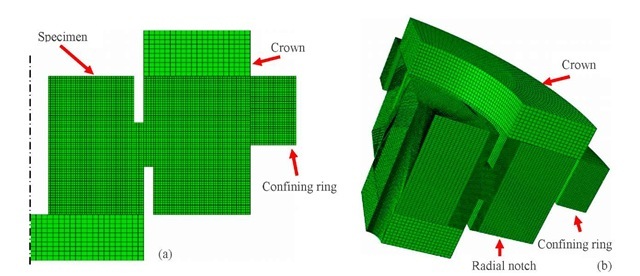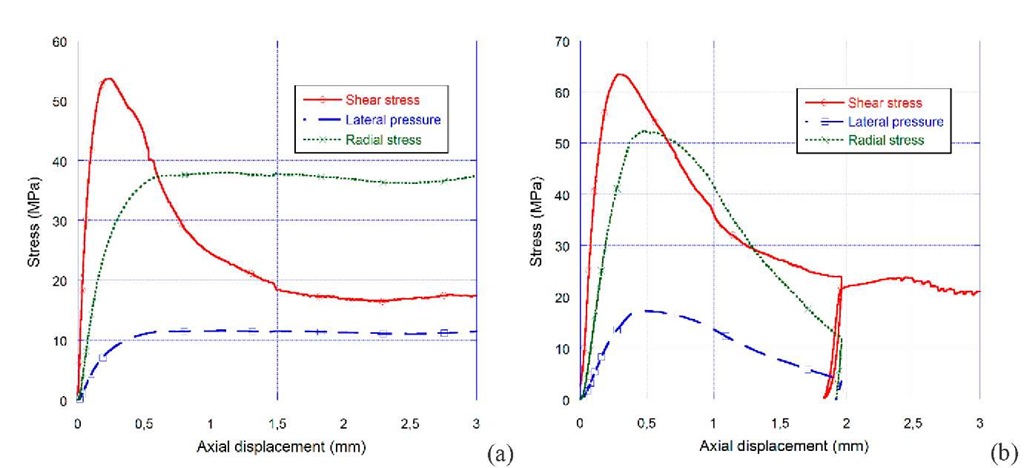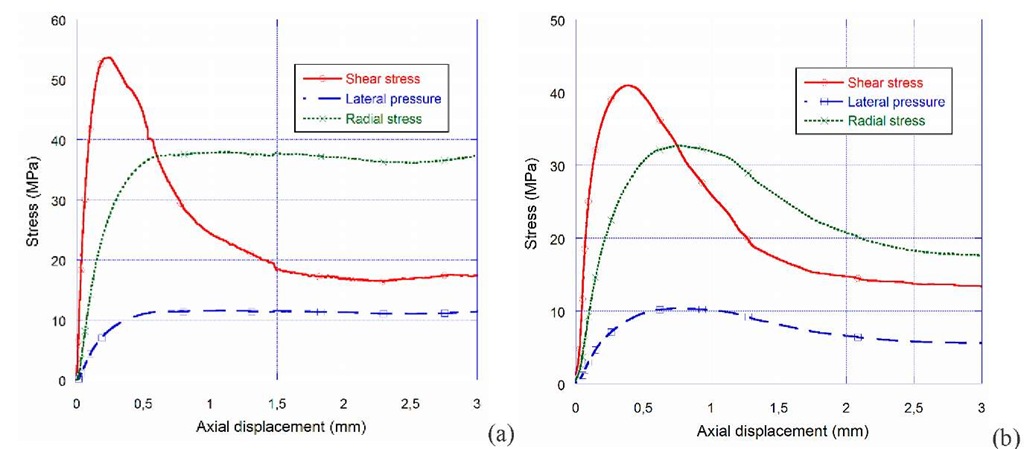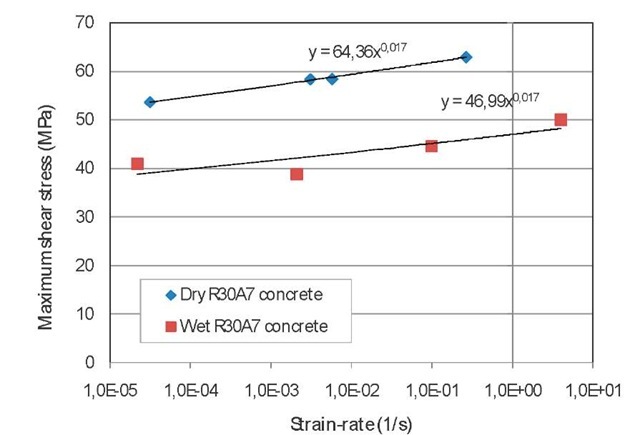ABSTRACT
The paper presents an experimental method used to investigate the shear behaviour of concrete and rock-like materials in quasi-static and dynamic loading. This method is based on the use of Punch-Through Shear (PTS) specimen and a passive confining cell. PTS sample is a short cylinder in which two cylindrical notches are performed. The displacement of the central zone beside the peripheral zone produces a shear fracture in the ligament. Metallic (steel or aluminium) confining ring allows inducing a confining pressure in the fractured zone due to the dilating behaviour of concrete under shear deformation. The experimental configuration has been designed through a series of numerical simulations in which the Drucker-Prager plasticity model is used for modelling the concrete behaviour. Computations showed the necessity to practice radial notches in the peripheral zone of the sample for deducing the radial stress in the ligament from data of strain gages glued on the outer surface of the confining ring. Finally this experimental method was employed to analyse the strain-rate and pressure sensitivity of dry and wet concrete under shear loading.
Introduction
Concrete structures as bridges, nuclear power stations or bunkers can be exposed to intensive dynamic loadings such as earthquakes, industrial accidents or projectile-impacts. During such loading, tensile and shear damage modes as spalling, scabbing, cratering, shear fracturing can be observed [1, 2, 3, 4]. In a case of penetration of a rigid projectile in the core of a target triaxial compression and shear stresses are generated, and the inertia of the surrounding material creates a passive confinement in front of the projectile. To improve the understanding and modelling of concrete behaviour under such confined loading, quasi-static and dynamic shear tests have been developed in LEM3 laboratory.
In the last decades, several experimental techniques have been used to characterise the confined or unconfined shear strength and mode II fracture toughness of concretes and rock like materials. Compression-Shear Cube tests were pioneered by Rao [5] to investigate the influence of confining pressure on the mode II fracture toughness of marble and granite. The author observed a linear increase of the stress intensity factor in mode II (KnC) with the confining level. The Short Beam Compression test relies on the use of samples with 2 notches orientated perpendicular to the loading direction. This technique allowed investigating the quasi-static and dynamic unconfined shear strength of concretes [6, 7]. The authors noted low strain-rate sensitivity in comparison to results obtained in dynamic tension. The Punch Through Shear Test (Fig. 1a) was introduced by Watkins [8] and used more recently by Backers [9] to determine the stress intensity factor in mode II of six types of rock as function of confining pressure. The cylindrical specimen includes two cylindrical notches on top and bottom faces. In a first step, the specimen is subjected to a pure hydrostatic pressure. In a second step an axial load is added to create the shearing state. This technique was also used by Montenegro et al [10] to investigate the shear behaviour of concrete and fracture energy of concrete as function of the hydrostatic pressure (Fig. 1b). The authors noted a significant increase of strength and fracture energy with confining pressure. However, supposedly due to strong difficulties in performing dynamic tests with a hydraulic confinement, very few authors have investigated the confined shear strength of concrete and rock-like materials in a wide range of strain-rate. In the present work, in a similar way than in quasi-oedometric compression tests [11, 12] a passive confining cell has been applied to Punch-Through-Shear specimens to characterise the confined shear strength of concrete over a wide range of strain-rates (Fig. 1c). Inner diameter of the lower notch and outer diameter of upper notch coincide so a straight cylindrical fracture surface is obtained (Fig. 1c). Numerical simulations of shear testing, experimental method, data processing and some experimental results are detailed in the present paper.
Fig. 1. Punch-Through-Shear tests (a) conducted by Backers [9], (b) by Montenegro et al. [10] (c) and in the present work.
Experimental method
Numerical simulation of PTS tests
2D-axisymetric (Fig. 2a) and 3D (Fig. 2b) numerical simulations of shear tests have been performed to set the dimensions of the confining cell and concrete sample. The Drucker-Prager model was used for the specimen to describe the pressure sensitivity and dilation behaviour of concrete. The length of the ligament (10 mm) allows ensuring an almost homogeneous shear stress field in the ligament. Moreover the confining ring is not centred toward the symmetry plane of the specimen to get a uniform pressure between the confining ring and the concrete sample (Fig. 2a). Finally, aluminium and steel confining rings 10 mm thick and 15 mm in height have been considered for quasi-static and dynamic experiments.
Fig. 2. (a) Mesh of 2D axisymetric computation, (b) Mesh of 3D computation.
Furthermore, 3D computations (Fig. 2b) have been performed to investigate the influence of radial notches on the stress fields in the sample. It was demonstrated that 4 radial notches at 90° through the outer part of the specimen allow avoiding a self confinement of the sample and any radial cracks triggered during the test.
Experimental procedure
The experimental devices used in quasi-static and dynamic shear testing are presented on Fig. 3a and 3b. Prior to each test a bi-component resin (Chrysor®) has been used to fill the gap between the sample and the confining ring. Moreover, the mean radial stress in the ligament (sheared zone) is deduced from the contact force between the sample and the confining vessel knowing the contact surface between the specimen and the ring (Scontact) and the area of the fracture surface (Sligament):
Fig. 3. Shear tests performed on R30A7 standard concrete. (a) Concrete specimen with radial notches after shear testing, (b) Concrete sample without radial notches after shear testing, (c) Device used in quasi-static shear testing, (d) Device used in dynamic shear testing and high-speed hydraulic press (LEM3).
In a similar way than in quasi-oedometric test [11, 12] the contact pressure between the sample and the confining ring is deduced from data of strain gages glued on the metallic cell (Fig. 3a and 3b). A high-speed hydraulic press has been used to perform shear tests for jack speed above 0.01 m/s. Above this loading rate, a damping system is included (Fig. 3d) to assure a correct balance of the specimen (equal input and output forces) and to avoid any shock waves. In dynamic tests laser extensometers have been used to deduce the axial displacement of the central part of the specimen. The mean shear stress in the ligament is obtained from the axial load according to Equation (2):
Tested concrete
Basic mechanical properties and composition of the tested concrete are gathered in Table 1. R30A7 concrete is a standard concrete containing hard siliceous aggregates with a grain size from 2 to 8 mm, sand, cement and water. All the specimens have been cored out from large blocks and stored in water saturated by lime in order to avoid the dissolution of portlandite in water. Two sets of specimens have been considered for shear testing: saturated specimens have been kept in water until few minutes before testing. "Dry" specimens were oven-dried at 60°C during several weeks until a constant weight has been achieved.
Table 1. Composition and quasi-static compression strength of dry and wet R30A7 concretes
|
Composition |
R30A7 [13] |
|
|
Aggregates [kg/m3] |
|
1008 |
|
Sand [kg/m3] |
838 |
|
|
Cement [kg/m3] |
263 |
|
|
Water [kg/m3] |
169 |
|
|
Water/Cement |
0.64 |
|
|
Mechanical properties |
Wet R30A7 Dry R30A7 |
|
|
Density |
2380 |
2290 |
|
Young modulus (GPa) [14] |
40 |
30 |
|
Quasi-static compression strength (MPa) [13] |
32 |
42 |
Measurement results
Influence of lateral pressure
A series of confined shear experiments has been conducted with both confining rings (aluminium or steel rings) and varying the concrete moisture and loading rate. A comparison of shear tests performed with dry samples is proposed on Fig. 4. After the stress peak, a strong softening behaviour is noted followed by a plateau. Similar trends have been reported in hydraulic confinement PTS experiments [10]. The plateau results supposedly from the friction on the fractured surface. Moreover the lateral pressure between the confining cell and the specimen deduced from data of strain gages is also plotted. The resulting radial stress in the shear zone is computed from Eq. 1. According to Fig. 4 the maximum radial stress reaches about 52 MPa (in absolute value) with the steel confining ring whereas it does not exceed 38 MPa with the aluminium cell. This difference of confining pressure may explain the difference in shear strength observed between both tests. A confirmation that pressure sensitivity of concrete under shear loading may be explored through PTS experiments with passive confining cells varying the stiffness of the ring.
Fig. 4. Results of quasi-static shear tests performed on dry specimens with (a) aluminium and (b) steel confining cells. Strain-rate: 2e-5/s, concrete samples with radial notches.
Influence of moisture content
Experimental results obtained with dry and wet specimens in quasi-static loading with an aluminium alloy confining vessel are reported on Fig. 5. In wet specimen the maximum shear stress reached 41 MPa whereas a maximum value of 54 MPa was obtained in dry sample. Again a strong decrease of shear stress is observed after the stress peak. Again the change of lateral pressure between the confining cell and the specimen is reported on the same plot as well as the resulting radial stress in the shear zone. Oppositely to Fig. 4 a similar radial stress about 30 MPa (in absolute value) is observed in both tests (dry and wet specimens) in the shear zone when the peak shear stress is reached.
Fig. 5. Results of quasi-static shear tests performed on dry (a) and wet (b) specimens. Strain-rate: 2e-5/s, aluminium confining cell, concrete samples with radial notches.
Influence of strain-rate
A series of shear tests has been performed with dry and wet samples and the aluminium confining ring varying the strain-rate from 2e-5/s to 4/s. Experimental results are gathered on Fig. 6. The shear strength of wet samples is markedly lower than that of dry specimens whatever the loading rate.
Furthermore, a very limited increase of strength is pointed out for both sets of specimens (dry and wet sets). This result significantly differs to the conclusion obtained for concrete under tensile loading. Indeed, as shown by several authors [4, 14, 15] the tensile strength of wet concrete is double in a similar strain-rate range (1e-6/s – 1/s) whereas a quasi-nil rate-effect is noted with dry specimens. Thus, the well-known Stephan effect supposed to explicate the strain-rate sensitivity of wet concrete in tension is supposedly inoperative under shear loading.
Fig. 6. Quasi-static and dynamic shear tests performed on dry and wet specimens (aluminium confining cell, concrete samples with radial notches).
Summary
An experimental method is proposed to investigate the shear behaviour of concrete under quasi-static and dynamic loading. The set-up based on PST (Punch Through Shear) testing technique relies on the use of a passive confining ring. Radial notches are also performed on each sample so the radial stress in the ligament may be deduced from the measurement of strain-gauges glued on the confining ring skirting around the effect of self confinement due to the peripheral part of the specimen. Geometries of the specimen and of the ring have been defined through a series of numerical simulations.
Experiments have been conducted on dry and water saturated concrete samples over a large range of strain-rate with two confining cells (steel and aluminum rings). The obtained results show a higher strength with dry samples than in wet ones and with the steel ring than with the aluminum ring. Furthermore, oppositely to previous results obtained in the literature in tension, both sets of concrete (dry and wet sets) show very small strain-rate sensitivity in the considered range of strain-rate. The so-called Stephan effect is though to be inoperative under shear loading.
![Punch-Through-Shear tests (a) conducted by Backers [9], (b) by Montenegro et al. [10] (c) and in the present work. Punch-Through-Shear tests (a) conducted by Backers [9], (b) by Montenegro et al. [10] (c) and in the present work.](http://what-when-how.com/wp-content/uploads/2011/07/tmp1927_thumb.jpg)







